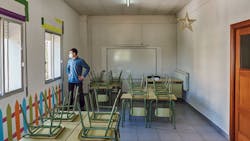EPA awards $34 million in grants to combat indoor air pollution in schools
Aug. 22, 2024
3 min read
The U.S. Environmental Protection Agency has awarded $34 million in grant funding to five organizations to address indoor air pollution in schools.
The EPA says in a news release that the grants will support initiatives to monitor and reduce greenhouse gas emissions and indoor air pollution at schools from kindergarten through grade 12 in low-income, disadvantaged, and Tribal communities.
“Children spend so much of their day in school," said EPA Deputy Administrator Janet McCabe. "It is critical for their health and academic success that schools have clean and healthy air. These grants will put schools in the best position to improve attendance and academic achievement, while addressing the unique and disproportionate health impacts that children in overburdened communities face as a result of indoor air quality challenges.”
The grants will go to the following entities:
- The University of Utah will support the development of indoor air quality management and greenhouse gas reduction plans for schools in urban and rural areas in Utah and Nevada, as well as with the Northern Arapaho Tribe in Wyoming. This will be accomplished through energy efficiency assessments of school buildings, indoor/outdoor air pollutant monitoring, demonstration of effectiveness of air pollution reduction strategies, development of an indoor air quality school phone app, community engagement, training, educational activities, and by providing indoor air quality and greenhouse gas reduction guidance to schools.
- The U.S. Green Building Council’s Center for Green Schools will build capacity among school district staff in low-income, disadvantaged and Tribal communities to establish indoor air quality management and greenhouse gas reduction plans. The program places direct emphasis on making capacity building and training activities more accessible to school district staff serving low-income, disadvantaged, and Tribal communities.
- The Go Green Initiative will partner with the National School Boards Association and their state affiliates to provide education and training for school staff, administrators, and school board officials involved in improving school indoor air quality and reducing climate pollution.
- The American Lung Association will deploy the Clean Air School Challenge to raise awareness, educate, build capacity, increase implementation, and recognize the efforts of schools in low-income, disadvantaged, and Tribal communities nationwide as they carry out comprehensive indoor air quality and greenhouse gas management plans.
- The New York State Department of Health and Health Research, Inc. will provide capacity building in indoor air quality and greenhouse gas reduction in disadvantaged and Tribal schools throughout New York State and additional states. The two organizations will draw on past experience to enable hundreds of disadvantaged and Tribal schools in New York to adopt sustainable indoor air quality management plans to make air quality improvements and greenhouse gas reductions.
The EPA says about half of K-12 students attend schools that do not have indoor air quality management plans or programs in place. Air quality in schools is of particular concern because children's developing organ systems are often more sensitive to environmental stressors, and children are frequently more heavily exposed to toxic substances in the environment than are adults. Children breathe more air in proportion to their body weight than adults.
About the Author
Mike Kennedy
Senior Editor
Mike Kennedy has been writing about education for American School & University since 1999. He also has reported on schools and other topics for The Chicago Tribune, The Kansas City Star, The Kansas City Times and City News Bureau of Chicago. He is a graduate of Michigan State University.
Sign up for our eNewsletters
Get the latest news and updates
